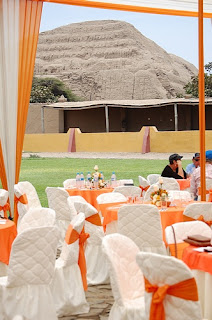We start by boarding a Coache Cama (Bed Bus). It is a high-end, double-decker with very comfortable seats. When used for intercountry transportation, the seats become sleeper seats and the coach would have one or more stewardesses with beverage and food service. It is always interesting to see these large busses with two sets of steerable wheels in front and two or three axles in the rear.
Driving north out of the industrial port of Salaverry, we head for the coastal, "resort," village of Huanchaco to see the "Little Horses." The Spanish word for them is "Caballito." These are reed rafts used for fishing. They are not truly rafts but more like half of a canoe which the fisherman straddles. They are made after a design that goes back at least 2,000 years. It takes an experienced fisherman about two hours to make one and it lasts about a month before becoming waterlogged and useless.
Leaving the beach where we saw these boats demonstrated, we drive back through the "resort"
and move on to the city of Chan Chan, the largest "mud" (adobe) city in the world. This was the capital of the Chimu civilization, the predecessors of the Incas. It was built about 1000AD and covered 20 square kilometers. At its peak, it boasted 60,000 inhabitants and was very rich with gold, silver and ceramics. Currently they have about 14 square kilometers under preservation and some restoration.
Today, the city is a plain near the Pacific showing decayed, decaying and stabilized walls of mud brick.
Inside the tourist area, one can see some original decoration of the walls. Many of these walls have been stabilized with a cap of cement made to look like the adobe. Some of the exterior walls of the city are still 40 feet tall! Originally, there would have been a mixture of open and thatch covered areas.
Leaving Chan Chan, we drive to the colonial city of Trujillo, visit one of the old colonial houses which is now a museum
and walk around the Plaza de Armas or main square which is surrounded by beautiful Spanish colonial building painted amazingly bright colors.
The people must have done this to give the truly grey landscape some life! From there we drive to a hacienda
where we are served a Pisco Sour and lunch followed by a demonstration of the "Caballo Pasado" or "Dancing Horses,"
and then an exhibition of the Peruvian National Dance, the "Marinera."
As a special we get to see a week old colt and her dancing mother. The colt is already trying to imitate her mother as she "dances" for us. The colt is really cute!
These were built by the Mochica culture, during the Moche period, which begin before the birth of Christ and continued until the rise of the Chimu civilization and Chan Chan. The Huaca of the Sun was, before the Spanish destroyed a substantial portion of it by diverting a river to wash it away in their search for gold, the largest mud/adobe pyramid in the world. It has not yet been excavated and is not open to the public. It looms up right beside the road into the area and is still an amazing sight.
The Huaca of the Moon is less visually impressive from a distance and sits up on the side of Cerro Blanco (White Mountain).
It however, is open to the public and has been under archaeological investigation since 1990. It is a long, steep climb up the side of a barren hillside to the entrance. It is estimated that the structure contains over 50,000,000 mud bricks and inside the archaeologists are stripping away layers of mud brick to reveal impressive, colorful wall frescoes that have been buried in the walls for centuries.
Each time the Mochica remodeled the temple, they buried the old walls and their decorations inside the new construction, thus protecting them for us to see today.It is a steep climb and lots of steps so Carolyn, along with another lady, waits in the coach and listens to her iPod. She will have to be content with Dick’s pictures.
Finally, leaving the Huaca of the Moon, we return to the ship 20 minutes past the "all aboard" time. They immediately cast off the lines and we sail for our next port of call Callao for Lima. Dick takes a quick shower, puts on clean clothes and heads for Team Trivia, the results of which we will not discuss here. For dinner, we meet members of the trivia team and their spouses in the Compass Rose. One of the team members was born in England in 1929 and, with urging from Dick, he recounts living in Britain during WWII. At the age of 10, on September 2, 1939, he was one of the millions of children evacuated from the big cities of England to the farms in the countryside for their safety. He did not see his parents again for 2½ years. All in all, it is a very pleasant day and a good dinner. Tomorrow is Lima for another overnight stay.




























No comments:
Post a Comment